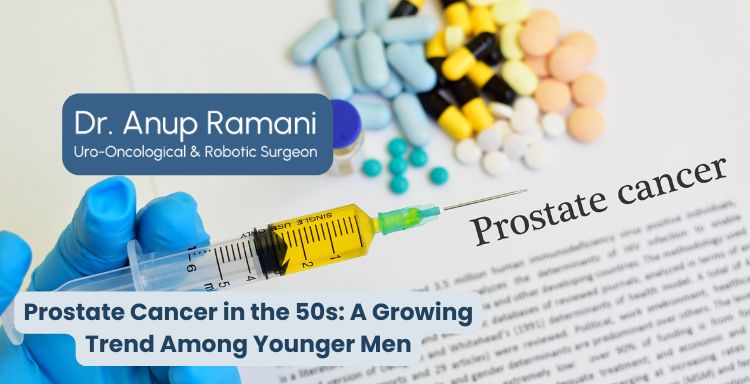Dr Anup Ramani @ Copyright 2024
By Dr. Anup Ramani
Prostate cancer is widely regarded as a disease primarily affecting older men, with the average age of diagnosis traditionally being over 65. However, recent trends indicate a shift in this pattern. More men in their 50s are being diagnosed with prostate cancer and this growing trend has raised concerns among healthcare professionals and patients alike. Early detection and advancements in treatment options, such as robotic radical prostatectomy, are making it easier to manage prostate cancer at a younger age, but this rise in diagnoses signals an urgent need for greater awareness and understanding of prostate health in men under 60.
This article examines why prostate cancer is becoming more prevalent in men in their 50s, the risk factors involved and the treatment strategies available for those diagnosed with the disease at this relatively young age.
What Are the Key Factors Contributing to the Rise of Prostate Cancer in Men in Their 50s?
Prostate cancer has traditionally been seen as an older man’s disease, with most diagnoses occurring after age 65. However, recent studies have shown a troubling increase in diagnoses among men in their 50s. Several factors are contributing to this growing trend:
- Changes in Lifestyle and Diet: In recent decades, there has been a noticeable shift in lifestyle and dietary patterns among men. Increased consumption of processed foods, high-fat diets and lower physical activity levels have all contributed to a rise in obesity, which is a known risk factor for prostate cancer. Poor dietary choices, particularly those high in red meat, fats and dairy products, are linked to increased inflammation in the body, which could potentially lead to cancer development, including prostate cancer.
- Obesity and its Impact on Prostate Cancer Risk: Obesity has become more prevalent in younger populations and its link to various types of cancer, including prostate cancer, is well-documented. Men who are overweight or obese are more likely to develop aggressive forms of prostate cancer at a younger age. Fat tissue produces excess estrogen, which may stimulate the growth of prostate cancer cells. The combination of hormonal imbalances and the increased inflammatory markers associated with obesity may be driving the uptick in diagnoses among men in their 50s.
- Genetic Predisposition and Family History: Family history continues to play a major role in prostate cancer risk. Men with a first-degree relative (father or brother) who has had prostate cancer are at a significantly higher risk of being diagnosed with the disease. This familial risk factor means that men with a family history of prostate cancer may begin to see symptoms or receive a diagnosis at a younger age, including during their 50s. Genetic mutations, typically associated with breast and ovarian cancers, have also been linked to prostate cancer, especially in younger men.
- Increased Awareness and Screening: Advances in prostate cancer screening, particularly the widespread use of the Prostate-Specific Antigen (PSA) test, have contributed to the earlier detection of prostate cancer. In the past, men in their 50s may not have undergone regular screening unless they exhibited symptoms, often leading to delayed diagnoses. However, with greater awareness of the importance of early detection, more men in their 50s are seeking regular screenings, resulting in a higher number of diagnoses at younger ages. Increased awareness campaigns and healthcare initiatives focusing on men’s health may be encouraging more men to check for potential issues, even before symptoms arise.
- Environmental and Hormonal Factors: Environmental toxins and endocrine-disrupting chemicals, such as those found in pesticides and plastics, are increasingly linked to various cancers, including prostatectomy surgery. Exposure to these chemicals may alter hormone levels and contribute to the development of cancer. Men in their 50s may have had prolonged exposure to these harmful substances throughout their lives, particularly if they grew up in industrialized areas or worked in environments where such chemicals were prevalent. Hormonal shifts, both from aging and environmental factors, may also contribute to prostate cancer development.
- Increased Life Expectancy and Medical Advancements: As men live longer due to improvements in healthcare and overall lifestyle, more individuals are reaching an age where prostate cancer may become more common. Furthermore, with increased advancements in medical technology, prostate cancer is being detected earlier and men are surviving longer, allowing the disease to be diagnosed in a larger cohort of younger men.

How Are Changing Lifestyle Habits Contributing to Prostate Cancer in Men in Their 50s?
The modern lifestyle plays a crucial role in the rising incidence of prostate cancer, particularly in men in their 50s. Lifestyle factors such as diet, exercise and environmental influences can significantly affect prostate health.
- Dietary Factors: Diets rich in processed foods, sugars and unhealthy fats are associated with a higher risk of many chronic diseases, including prostate cancer. Increased consumption of red meat, high-fat dairy and fried foods is believed to contribute to an inflammatory environment in the body, which may promote the growth of cancerous cells in the prostate. Conversely, diets high in fruits, vegetables and omega-3 fatty acids may help reduce the risk of prostate cancer treatment. Unfortunately, modern diets often skew toward processed and fast foods, which are linked to obesity and cancer risk.
- Physical Inactivity: Sedentary lifestyles have become more common in modern society, with men in their 50s often working long hours at desks and spending more time in front of screens. Lack of physical activity contributes to obesity, which, as previously mentioned, is a significant risk factor for robotic prostatectomy surgery. Exercise has been shown to have protective effects, improving overall health and reducing the risk of various cancer.
- Stress and Sleep Deprivation: Chronic stress and poor sleep patterns, both increasingly prevalent in today’s fast-paced world, have also been linked to a higher risk of developing cancer. Stress can lead to hormonal imbalances and prolonged sleep deprivation can weaken the immune system, making the body more susceptible to diseases like prostate cancer.
- Alcohol and Smoking: Excessive alcohol consumption and smoking are other modifiable risk factors that may increase the likelihood of developing prostate cancer. These habits have been associated with poorer overall health, reduced immune function and an increased risk of various types of cancer, including prostate cancer.
What Our Patients Are Saying
What Is the Impact of Early Prostate Cancer Detection in Men in Their 50s?
The growing trend of diagnosing prostate cancer in men in their 50s has a profound impact on how the disease is managed. Early detection, driven by increased screening awareness and improved diagnostic tools, can significantly improve treatment outcomes. However, this rise in diagnoses also has some implications:
- Increased Demand for Prostate Cancer Specialists: As prostate cancer diagnoses rise in younger men, the demand for specialized prostate cancer surgeons, oncologists and other healthcare professionals is expected to increase. Men in their 50s are likely to require more personalized care, particularly if the cancer is detected early and requires ongoing monitoring or treatment. This shift may place more pressure on healthcare systems to provide sufficient resources and expertise for managing prostate cancer at this age.
- Focus on Prevention and Lifestyle Changes: With more men being diagnosed at an earlier age, the emphasis on prevention and lifestyle modification becomes more urgent. Encouraging younger men to adopt healthier lifestyles, including regular exercise, a balanced diet and routine screenings, can help reduce the overall risk of prostate cancer surgery and improve long-term health outcomes.
- Psychological and Emotional Impact: Robotic prostate cancer surgery at an earlier age can have significant psychological effects. Men in their 50s are often still in the midst of their careers and family life, making a cancer diagnosis a major emotional challenge. Early interventions, including mental health support and counseling, may be crucial for helping younger patients navigate the emotional and psychological aspects of prostate cancer diagnosis and treatment.
Conclusion
Prostate cancer in men in their 50s is becoming a more common trend, driven by improved screening, lifestyle factors and genetic predispositions. Early detection is critical and men should begin regular screenings as they reach this age, especially if they have a family history of the disease. Treatment options such as robotic radical prostatectomy, radiation therapy and active surveillance provide patients with a range of choices, allowing them to personalize their care based on the severity of the cancer and their quality of life goals.
In cities like Mumbai, India, the increasing availability of advanced treatment methods, such as robotic surgery and precision medicine, is helping men in their 50s manage prostate cancer more effectively. The growing trend of prostate cancer diagnoses in younger men highlights the importance of proactive healthcare and early intervention.
FAQs
Why are more men in their 50s being diagnosed with prostate cancer?
Increasing awareness, improved screening methods, lifestyle factors such as poor diet and obesity and genetic predispositions are contributing to the rise in prostate cancer diagnoses in men in their 50s.
How does lifestyle impact prostate cancer risk in younger men?
A poor diet, lack of physical activity and obesity are linked to a higher risk of prostate cancer. These lifestyle factors promote inflammation and hormonal imbalances, which may contribute to cancer development.
Should men in their 50s be screened for prostate cancer?
Yes, men in their 50s, particularly those with a family history of prostate cancer or other risk factors, should begin discussions with their healthcare provider about screening for prostate cancer.
What role does genetic predisposition play in prostate cancer?
Men with a family history of prostate cancer are at a higher risk of developing the disease at a younger age. Genetic mutations, also increase prostate cancer risk.
How can lifestyle changes help reduce the risk of prostate cancer?
Adopting a healthy diet rich in fruits, vegetables and omega-3 fatty acids, engaging in regular physical activity and maintaining a healthy weight can help reduce the risk of prostate cancer. Avoiding excessive alcohol and smoking is also essential.
About Author

Uro-Oncological & Robotic Surgeon
Dr. Anup Ramani is a robotic uro-oncological surgeon and an internationally recognized expert in robotic surgery for prostate, kidney and urinary bladder cancers. With more than two decades of robotic experience and 2,000+ robotic procedures, he brings unmatched precision and outcomes to complex uro-oncology cases. He is widely published in his field and is known for a personal, transparent approach-often spending over an hour in initial consultations to educate patients on its disease, surgery and recovery. His expertise spans prostate cancer treatment, kidney and bladder cancer surgery, adrenal gland surgery, kidney stone treatment, penile cancer surgery and enlarged prostate management. Dr. Ramani advocates the advantages of robotic surgery-magnified 3D vision, tremor-filtered precision, minimal scarring, lower blood loss and faster recovery-helping patients return to life sooner.
Table of Contents
Recent Blogs
Best Uro-Oncological surgeon
Specialist in India for Robotic Surgery
MCh, DNB, MS, DNB
Dr. Anup Ramani
CONTACT
Uro-Oncologist in India,
Best Robotic Surgeon for Uro Oncology Surgery
1407, One Lodha Place Next to World Towers Senapati Bapat Marg, Worli, Mumbai. 400013.
Dr Anup Ramani @ Copyright 2024 – Website Maintenance, SEO & GEO by Opal Infotech
- Partial penectomy is done in cases where glans and distal penis is involved with carcinoma.
- Partial penectomy is a type of organ-preserving surgery. Preservation of sexual and micturational function depends on the surgical dissection and reconstruction of residual urethra.
- Patients who develop stones in the kidney or ureter, often experience severe pain.
- This condition usually needs a procedure to remove the kidney stones.
- This procedure is called ureteroscopy and is performed very commonly.
- It does not require any cuts and hence it is painless.
- The procedure is performed with an endoscope inserted through the penis under spinal anesthesia.
- The scope is inserted through the penis into the kidney and stones are dissolved with a laser.
- The procedure takes about 40-50 minutes.
- A catheter (urine pipe) is kept after the procedure to drain the bladder. A stent is kept in the kidney at the same time.
- Patient is mobile and walking in the room the same evening.
- Hospital stay is one night and patient is discharged the next day after removal of the catheter.
- Patient has to come back after six weeks to remove the stent in the kidney.
- Patients can resume office a week after surgery and heavy activities like running, weight lifting, a month after the procedure.
- We offer fixed packages for this procedure which can be obtained by calling our helpline +91 9967666060.
- Men with an enlarged prostate, which is a normal ageing changes, often experiencing difficulty passing urine. This condition usually needs a procedure to trim the prostate and relieve the blockage.
- This procedure is called TURP and is performed very commonly.
- It does not require any cuts and hence it is painless.
- The procedure is performed with an endoscope inserted through the penis under spinal anaesthesia.
- The overgrown prostate is dissolved with a laser bloodlessly.
- The procedure takes about 40 minutes.
- A catheter (urine pipe) is kept after the procedure to drain the bladder.
- Patient is mobile and walking in the room the same evening.
- Hospital stay is two nights and patient is discharged with the catheter, which is removed after 4 days.
- Patients can resume office a week after surgery and heavy activities like running, weight lifting, a month after the procedure.
- We offer fixed packages for this procedure which can be obtained by calling our helpline +91 9967666060.
-
Robotic adrenalectomy is a sophisticated, complex surgery and it is very important that an experienced surgeon performs this surgery to avoid major complications.
-
Once the anesthesia is done, and patient positioned, three micro cuts (3mm each) are made in the patient’s abdomen.
-
The arms of the Da Vinci robot are connected to the cuts via ports (tubes).
-
Dr. Ramani then sits in the controlling console to perform the surgery.
-
On an average, a robotic adrenalectomy takes one hour.
-
The surgery is almost completely bloodless and there has never been any need to transfuse blood after surgery.
-
A urine catheter and bag to drain the bladder is inserted during surgery.
-
A tiny drain pipe may be inserted in the surgical side of the abdomen, connected to a bag.
-
Patient is kept nil-by-mouth the day of the surgery, with IV fluids. Sips of water are started the next day and solid food by day three.
-
The drain pipe, if kept, is removed in the room on day 2 after surgery.
-
The catheter is removed on day two after surgery.
-
Total hospital stay for robotic adrenalectomy is 4 nights (including night before surgery).
-
Post discharge, a doctor from the surgical team visits the patient at home/ hotel room once every day.
On the day of discharge, patient is totally self-sufficient. They are able to walk freely without any pain, dress themselves, shower, toilet and they do not need to hire any nurse or help at home. Almost all patients are back to work within 2 weeks of surgery.
Heavy activities like running, weight lifting can be resumed after a month
Follow up after an adrenalectomy is in the form of CT scans, once a year for 5 years.
Local patients usually meet Dr. Ramani after two weeks to discuss report.Outstation patients are counselled on a phone consultation.
- Dr. Ramani is one of the very few surgeons in India who has the expertise to perform a robotic surgery for bladder cancer, which includes removing the urinary bladder and reconstructing a new bladder robotically.
- Robotic radical cystectomy is an extremely sophisticated, complex surgery and it is very important that an experienced surgeon performs this surgery to avoid major complications.
- Once the anaesthesia is done, and patient positioned, six micro cuts (3mm each) are made in the patient’s abdomen.
- The arms of the Da Vinci robot are connected to the cuts via ports (tubes).
- Dr. Ramani then sits in the controlling console to perform the surgery.
- On an average, a robotic radical cystectomy with an ileal conduit takes 3-4 hours.
- The surgery is almost completely bloodless and there has never been any need to transfuse blood after surgery.
- A urine catheter and bag to drain the new bladder is inserted during surgery.
- Two tiny drain pipe in inserted in the surgical side of the abdomen, connected to a bag.
- Patient is kept nil-by-mouth for 4 days after surgery with IV supplementation of patient’s daily requirements of calories, fats, carbohydrates, proteins and electrolytes.
- The drain pipes are removed in the room on day 3-5 after surgery.
- Total hospital stay for radical cystectomy is 8 nights (including night before surgery).
- Post discharge, a doctor from the surgical team visits the patient at home/ hotel room once every day.
- On the day of discharge, patient is totally self-sufficient. They are able to walk freely without any pain, dress themselves, shower, toilet and they do not need to hire any nurse or help at home.
- Almost all patients are back to work within 6 weeks of surgery. Heavy activities like running, weight lifting can be resumed after two months.
Follow up after a radical a cystectomy is in the form of CT scans, once a year for 5 years.
Histopathology report: Local patients usually meet Dr. Ramani after two weeks to discuss report.
Outstation patients are counselled on a phone consult. Depending on the report, patient may or may not need chemotherapy after surgery.
If chemo is needed, patients may choose to get it done with a medical oncologist of their choice or avail the services of one of the four medical oncologists on our team.
- Robotic partial nephrectomy is a sophisticated, complex surgery and it is very important that an experienced surgeon performs this surgery to avoid major complications. Robotic radical (total) nephrectomy is
- relatively easier but still requires significant experience to consistently deliver results.
- Once the anaesthesia is done, and patient positioned, five micro cuts (3mm each) are made in the patient’s abdomen.
- The arms of the Da Vinci robot are connected to the cuts via ports (tubes).
- Dr. Ramani then sits in the controlling console to perform the surgery.
- On an average, a robotic radical nephrectomy takes one hour and a robotic partial nephrectomy takes about an hour and half.
- The surgery is almost completely bloodless and there has never been any need to transfuse blood after surgery.
- A urine catheter and bag to drain the bladder is inserted during surgery.
- A tiny drain pipe in inserted in the surgical side of the abdomen, connected to a bag.
- Patient is kept nil-by-mouth the day of the surgery, with IV fluids. Sips of water are started the next day and solid food by day three.
- The drain pipe is removed in the room on day 3 after surgery. The catheter is removed on day two after surgery.
- Total hospital stay for radical/partial nephrectomy is 4 nights (including night before surgery).
- Post discharge, a doctor from the surgical team visits the patient at home/ hotel room once every day.
- On the day of discharge, patient is totally self- sufficient.
- They are able to walk freely without any pain, dress themselves, shower, toilet and they do not need to hire any nurse or help at home.
- Almost all patients are back to work within 2-3 weeks of surgery.
- Heavy activities like running, weight lifting can be resumed after a month.
- Follow up after a radical/partial Nephrectomy is in the form of CT scans, once a year for 5 years.
- Local patients usually meet Dr. Ramani after two weeks to discuss report.
- Outstation patients are counselled on a phone consultation.





